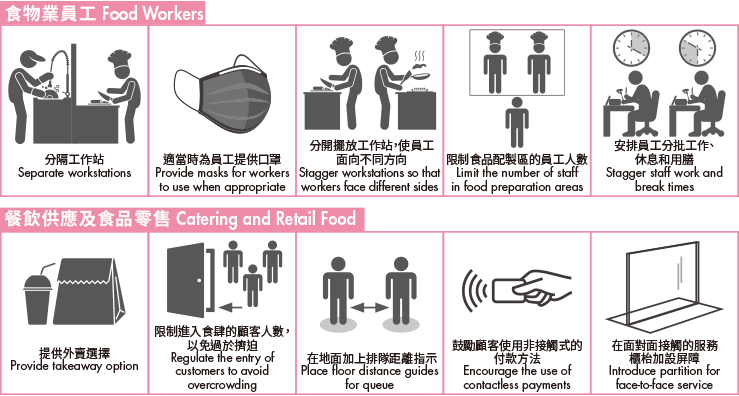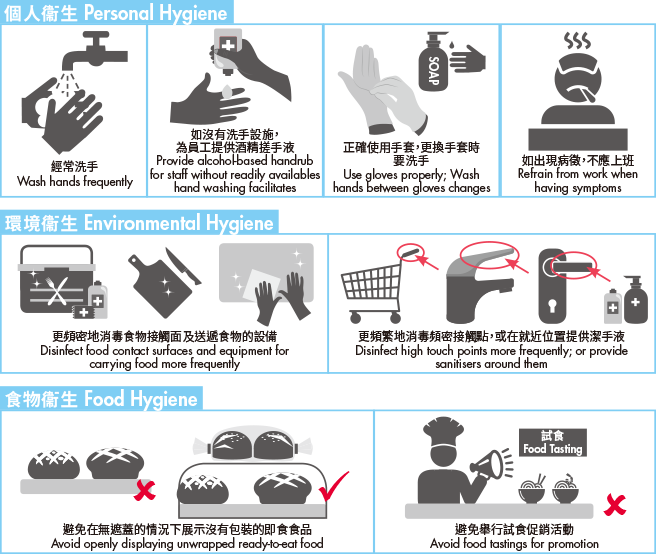
Food Safety Focus (166th Issue, May 2020) – Food Safety Platform
More Issues on COVID-19 in Food Business
Reported by Dr. Ken CHONG, Scientific Officer,
Risk Communication Section, Centre for Food Safety
While the main mode of transmission of coronavirus disease 2019 (COVID-19) is through respiratory droplets, it can also be transmitted through contact. This makes some people concern whether touching contaminated objects, including food packaging, could contract the disease. In this issue, we will look into the matters related to COVID-19 in food business and highlight key hygienic measures.
Can COVID-19 be Transmitted by Food Packaging?
Recent research suggested that the novel coronavirus can survive on surfaces or objects for few hours to several days under controlled, experimental conditions. However, the virus cannot multiply in food or food packaging. The risk of acquiring the virus through food packaging appears to be very low in the real-life situation. The World Health Organization states that it is highly unlikely that people can contract COVID-19 from food or food packaging. To date, there is also no evidence of viruses that cause respiratory illnesses being transmitted via food or food packaging. Among some 1000 cases reported locally in Hong Kong by far, there is no case identified to be potentially transmitted through food packaging.
Should Consumers Sanitise Food Packaging?
In fact, contaminated hands play a significant role in facilitating indirect contact transmission by transferring the infectious virus from one surface to another and even into one’s body. Instead of food packaging, transmission is more likely to happen in contact with certain high-touch points, such as door handles, handles of the shopping trolleys and water taps – the more frequently being touched by different people, the higher the risk that it becomes contaminated. Therefore, while some people may still opt to disinfect food packaging surfaces with common household disinfectants such as alcohol-based wipes or sprays if needed, it is more important for people to wash their hands thoroughly, especially before touching eyes, nose and mouth, after returning home from grocery shopping and after handling and storing purchased products.
What Can Food Business Do to Fight COVID-19 Together?
While food business continues to cater for daily needs of the public, it is important to set up appropriate hygienic measures to ensure the health of employees and consumers. It is crucial that people with fever or respiratory symptoms should refrain from work and avoid going to crowded places, wear a surgical mask and seek medical advice promptly. Staff should wear a surgical mask when required to work face to face with the public or in a crowded area, as well as having their body temperature checked regularly. Other measures include disseminating health advice to employees, providing hand-washing facilities and ensuring a clean and hygienic work environment. Clean and disinfect surfaces frequently, particularly high touch points in stores of food business. Food workers should wash hands frequently and refrain from work and seek medical advice when having symptoms of COVID-19 such as fever, cough and shortness of breath. Maintain physical distancing, i.e. at least 1 metre between persons, in food business environments as far as possible to reduce the risk of disease transmission. Wherever there is space constraint to allow sufficient physical distance, other separation measures can be considered. (See Figure 1)
 Figure 1: Physical Distancing in Food Business.
Figure 1: Physical Distancing in Food Business.
In addition to the health advice given by the Centre for Health Protection, relevant recommendations on enhancing hygiene in food business to prevent the spread of COVID-19 are illustrated in Figure 2.
Figure 2: Enhancement of Hygiene
Last but not least, food business operators should continue to uphold food safety practices, e.g. the Five Keys to Food Safety, and the Hazard Analysis and Critical Control Point system to prevent foodborne illnesses.


